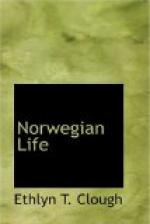It is but natural that the ancient Norwegians should become warlike and brave men, since their firm religious belief was that those who died of sickness or old age would sink down into the dark abode of Hel (Helheim), and that only the brave men who fell in battle would be invited to the feasts in Odin’s Hall. Sometimes the earls or kings would make war on their neighbors, either for conquest or revenge. But the time came when the countries of the north, with their poorly developed resources, became overpopulated, and the warriors had to seek other fields abroad. The viking cruises commenced, and for a long time the Norwegians continued to harry the coasts of Europe.
At first the viking expeditions were nothing but piracy, carried on for a livelihood. The name Viking is supposed to be derived from the word vik, a cove or inlet on the coast, in which they would harbor their ships and lie in wait for merchants sailing by. Soon these expeditions assumed a wider range and a wilder character, and historians of the time paint the horrors spread by the vikings in dark colors. In the English churches they had a day of prayer each week to invoke the aid of heaven against the harrying Northmen. In France the following formula was inserted in the church prayer: “A furore Normannorum libera nos, o Domine!” (Free us, O Lord, from the fury of the Northmen!)
Gradually the viking life assumed a nobler form. There appear to have been three stages or periods in the viking age. In the first one the vikings make casual visits with single ships to the shores of England, Ireland, France or Flanders, and when they have plundered a town or a convent, they return to their ships and sail away. In the second period their cruises assume a more regular character, and indicate some definite plan, as they take possession of certain points, where they winter, and from where they command the surrounding country. During the third period they no longer confine themselves to seeking booty, but act as real conquerors, take possession of the conquered territory, and rule it. As to the influence of the Northmen on the development of the countries visited in this last period, the eminent English writer, Samuel Laing, the translator of the Heimskringla, or the Sagas of the Norse kings, says:
“All that men hope for of good government and future improvement in their physical and moral condition—all that civilized men enjoy at this day of civil, religious, and political liberty—the British constitution, representative legislation, the trial by jury, security of property, freedom of mind and person, the influence of public opinion over the conduct of public affairs, the Reformation, the liberty of the press, the spirit of the age—all that is or has been of value to man in modern times as a member of society, either in Europe or in the New World, may be traced to the spark left burning upon our shores by these northern barbarians.”




